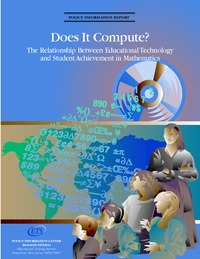Does It Compute?The Relationship between Educational Technology and Student Achievement in Mathematics
Harold Wenglinsky
Publikationsdatum:
|
 |
 Diese Seite wurde seit 1 Jahr inhaltlich nicht mehr aktualisiert.
Unter Umständen ist sie nicht mehr aktuell.
Diese Seite wurde seit 1 Jahr inhaltlich nicht mehr aktualisiert.
Unter Umständen ist sie nicht mehr aktuell.
 Zusammenfassungen
Zusammenfassungen
This report presents findings from a national study of the relationship between different uses of educational technology and various educational outcomes. Data were drawn from the 1996 National Assessment of Educational Progress (NAEP) in mathematics, consisting of national samples of 6,227 fourth graders and 7,146 eighth graders. Data include information on the frequency of computer use for mathematics in school, access to computers at home and in school, professional development of mathematics teachers in computer use, and the kinds of instructional uses of computers in the schools. The study finds that the greatest inequities in computer use are not in how often they are used, but in the ways in which they are used. Poor, urban, and rural students are less likely to be exposed to higher order uses of computers than nonpoor and suburban students. For both fourth and eighth grades, teachers of urban and rural students are less likely to have had professional development in technology than suburban teachers. There were few differences in the frequency of school computer use in either grade, although black fourth graders reported more frequent use than white fourth graders. Yet for both grades, black students were less likely to have a computer at school. In essence, the study found that technology could matter, but that this depended on how it was used. The size of the relationship between the various positive uses of technology and academic achievement was negligible for fourth graders, but substantial for eighth graders. Taken together, findings indicate that computers are neither a cure-all for problems facing the schools nor mere fads without impact on student learning. When used properly, computers may serve as important tools for improving student proficiency in mathematics and the overall learning environment of the school.
Von Harold Wenglinsky im Text Does It Compute? (1998)  Dieser Text erwähnt ...
Dieser Text erwähnt ...
 Personen KB IB clear | Chen-Lin Kulik , James A. Kulik | ||||||||||||||||||
 Begriffe KB IB clear | ICTICT
,  Lernen Lernen learning
, learning
,  Mathematik Mathematik mathematics mathematics
| ||||||||||||||||||
 Texte |
|
 Zitationsgraph
Zitationsgraph
 Zitationsgraph (Beta-Test mit vis.js)
Zitationsgraph (Beta-Test mit vis.js)
 8 Erwähnungen
8 Erwähnungen 
- The Impact of Education Technology on Student Achievement - What the Most Current Research Has To Say (John Schacter) (1999)

- Assessing Effects of Technology on Learning - Limitations of Today's Standardized Tests (Michael Russell, Jennifer Higgins) (2003)


- Computers and Student Learning - Bivariate and Multivariate Evidence on the Availability and Use of Computers at Home and at School (Thomas Fuchs, Ludger Wößmann) (2004)


- New Technology and Digital Worlds - Analyzing Evidence of Equity in Access, Use, and Outcomes (2010)


- Technology and Social Inclusion - Rethinking the Digital Divide (Mark Warschauer) (2013)


- Cyberkrank! - Wie das digitalisierte Leben unsere Gesundheit ruiniert (Manfred Spitzer) (2015)

- Perceived quality of educational technology matters - A Secondary Analysis of Students' ICT Use, ICT-Related Attitudes, and PISA 2012 Test Scores (Dominik Petko, Andrea Cantieni, Doreen Prasse) (2016)


- Failure to Disrupt - Why Technology Alone Can’t Transform Education (Justin Reich) (2020)

 Volltext dieses Dokuments
Volltext dieses Dokuments
 |  Does It Compute?: Artikel als Volltext ( Does It Compute?: Artikel als Volltext ( : :  , 476 kByte; , 476 kByte;  : :  ) ) |
 Anderswo suchen
Anderswo suchen 
 Beat und dieser Text
Beat und dieser Text
Beat war Co-Leiter des ICT-Kompetenzzentrums TOP während er Dieser Text ins Biblionetz aufgenommen hat. Die bisher letzte Bearbeitung erfolgte während seiner Zeit am Institut für Medien und Schule. Beat besitzt kein physisches, aber ein digitales Exemplar. Eine digitale Version ist auf dem Internet verfügbar (s.o.). Aufgrund der wenigen Einträge im Biblionetz scheint er es nicht wirklich gelesen zu haben. Es gibt bisher auch nur wenige Objekte im Biblionetz, die dieses Werk zitieren.








 Biblionetz-History
Biblionetz-History